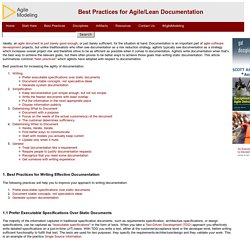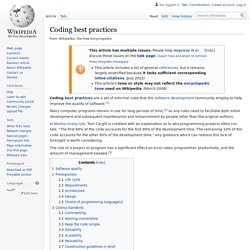

Best Practices for Agile/Lean Documentation. Ideally, an agile document is just barely good enough, or just barely sufficient, for the situation at hand.

Documentation is an important part of agile software development projects, but unlike traditionalists who often see documentation as a risk reduction strategy, agilists typically see documentation as a strategy which increases overall project risk and therefore strive to be as efficient as possible when it comes to documentation. Agilists write documentation when that's the best way to achieve the relevant goals, but there often proves to be better ways to achieve those goals than writing static documentation.
This article summarizes common "best practices" which agilists have adopted with respect to documentation. Best practices for increasing the agility of documentation: 1. The following practices will help you to improve your approach to writing documentation: 1.1 Prefer Executable Specifications Over Static Documents 1.2 Document Stable Concepts, not Speculative Ideas. Requirements analysis. Requirements analysis is critical to the success of a systems or software project.[3] The requirements should be documented, actionable, measurable, testable, traceable, related to identified business needs or opportunities, and defined to a level of detail sufficient for system design.

Overview[edit] Conceptually, requirements analysis includes three types of activities:[citation needed] Eliciting requirements:(e.g. the project charter or definition), business process documentation, and stakeholder interviews. This is sometimes also called requirements gathering.Analyzing requirements: determining whether the stated requirements are clear, complete, consistent and unambiguous, and resolving any apparent conflicts.Recording requirements: Requirements may be documented in various forms, usually including a summary list and may include natural-language documents, use cases, user stories, or process specifications. Requirements analysis topics[edit] Stakeholder identification[edit]
Best practices for software development projects. © Copyright International Business Machines Corporation 2003.

All rights reserved. Introduction Most software projects fail. In fact, the Standish group reports that over 80% of projects are unsuccessful either because they are over budget, late, missing function, or a combination. Moreover, 30% of software projects are so poorly executed that they are canceled before completion. This article contains a summary of best practices for software development projects. Back to top Best practices 1. 2. 3. 4. 5. 6. Best Coding Practices. Coding best practices are a set of informal rules that the software development community employ to help improve the quality of software.[1] Many computer programs remain in use for long periods of time,[2] so any rules need to facilitate both initial development and subsequent maintenance and enhancement by people other than the original authors.

In Ninety-ninety rule, Tom Cargill is credited with an explanation as to why programming projects often run late: "The first 90% of the code accounts for the first 90% of the development time. The remaining 10% of the code accounts for the other 90% of the development time. " Any guidance which can redress this lack of foresight is worth considering. The size of a project or program has a significant effect on error rates, programmer productivity, and the amount of management needed.[3] Software quality[edit] As listed below, there are many attributes associated with good software. Prerequisites[edit] how is development structured? Life cycle[edit] SWEBOK_Guide_2004.